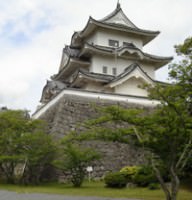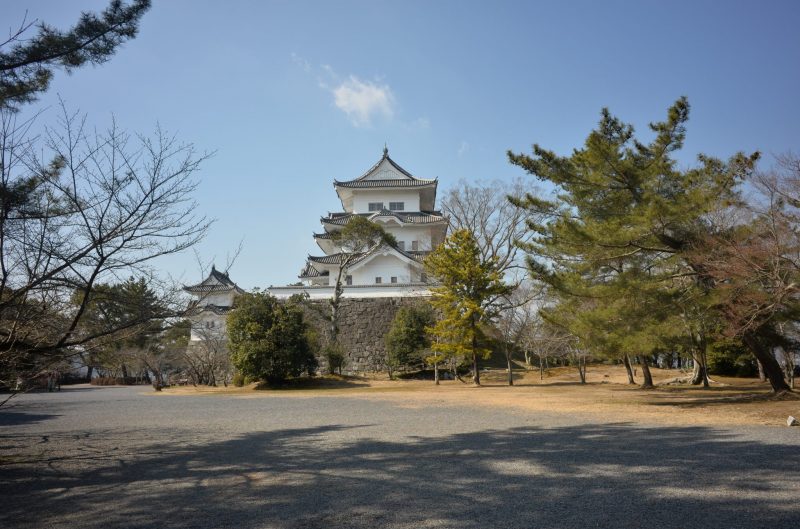
Located about half-way between Nagoya and Osaka, the city of Iga Ueno is a little hard to get to, but is a perfect day trip from either Osaka or Kyoto. Iga Ueno is most famous for ninja. The Iga school of ninjutsu (art of stealth), based in Ueno City, was at one time one of the two leading ninja schools in Japan during the late 15th and early 16th centuries (the Koga school in the nearby Shiga Prefecture was the other). Today, Iga Ueno attracts visitors with its excellent ninja museum. Iga Ueno is also known as the birthplace of one of Japan’s greatest poets, Basho Matsuo, who lived during the early Edo Period. A memorial museum, his birth home and a former hermitage are some of Ueno’s Basho related attractions. Iga Ueno is also known for the Iga Ueno Castle. Iga Ueno Castle is famous for having the highest stone walls in Japan. These stone walls were selected for use in a scene for the movie “Kagemusha,” directed by the internationally renowned film maker Akira Kurosawa.
History of Iga Ueno Ninjas
Ninja were the spies of Japan’s feudal ages, gathering information about the enemy
and conducting other acts of espionage and assassinations. It was during the early Muromachi period (early 14th century to late 15th century) that the people of the Iga region became effectively independent from their feudal overlords and established a kind of republic in their region. The Iga republic was called Iga Sokoku Ikki in Japanese. In 1579, warlord Oda Nobunaga’s son, Oda Nobukatsu launched an attack against the Iga Republic but was defeated by local troops and ninja mustered by the people of Iga. Oda Nobunaga could not allow his family’s loss of face to a band of ninja stand unanswered. So in 1581, he launched a massive invasion of Iga, attacking from six directions with a force of 40,000 to 60,000 men. After ruthlessly slaughtering many Iga ninja and their family members, Nobunaga declared a cease fire and allowed some of the ninja to escape.
In 1582, during the turmoil following Oda Nobunaga’s death, the Iga ninja Hattori Hanzo (yes, it is the same name from the movie Kill Bill Volume 1) gave the future shogun Tokugawa Ieyasu an escape route which passed through the Koga and Iga regions to enable Ieyasu’s safe return to the province of Mikawa. Ieyasu, when he became the shogun, employed ninja to guard the Edo Castle, the headquarters of the Tokugawa shogunate. Iga ninja were employed to guard key gates of the castle and were used as spies for the Shogun. The west gate of Edo Castle is called Hanzo’s Gate because the residence of the Hattori clan was near the gate.
Hattori Hanzo’s son, Hattori Masanari became the commander of the Iga guards at Edo Castle but he proved to be a less successful leader than his father when, in 1606, the Iga ninja rebelled against him due to harsh treatment. The Iga ninja continued to be employed by the Tokugawa clan shoguns until Tokugawa Yoshimune (ruled 1716-1745) dismissed all ninja from intelligence work and replaced them with people from his local Kii Province.
Ninja Yashiki Museum
The Iga-ryu Ninja Museum has an original ninja residence complete with trapdoors, secret passageways and revolving walls. A pink-clad female ninja talks visitors through the house’s many surprising secrets.
The museum has two further exhibition halls. The first uses audio-visual displays to demonstrate ninja techniques as well as displays of ninja weaponry (including shuriken – projectiles such as throwing stars and knives), armor and espionage tools. The second hall displays objects from the ninja’s lifestyle and culture including implements and techniques used in encryption, concealment and disguise. The highlight of the tour is the hourly ninja demonstration where present-day inheritors of the ninja tradition show off their skills in a combat exhibition using real weapons: straight ninja swords, shuriken and sickles.
Ueno Castle
Iga Ueno Castle was initially built by Sadatsugu Tsutsui but was expanded and converted to its present form after Takatora Todo succeeded Sadatsugu in 1611. Uncanny in his military prowess and political sense, Takatora sided with Tokugawa Ieyasu at the decisive Battle of Sekigahara in 1600 after serving the Toyotomi Hideyoshi shogunate. Takatora was also renowned as one of the finest castle architects of his time.
The castle tower was reconstructed as a five story wooden building in 1935 embodying the essence of the Momoyama style architecture of the late 16th century. With its elegant white walls, the castle is also known as the ‘Hakuho’ or ‘white phoenix’ castle for its resemblance to the fabled sacred white bird resting in green leaves. The walls surrounding the structure, at 30 meters tall, are said to be the highest in Japan. The castle was used as a shooting location for Kagemusha, a film directed by Kurosawa Akira in the early 1980’s.
The five story structure has an interior separated into three floors. Unlike many other castles in Japan, the main entry hall is very open and spacious. The first and second floors contain a collection of ancient artifacts such as armour, taiko drums, weapons, masks, scrolls, and palanquins, while the third floor has a great 360 degree view of Ueno city.
Matsuo Basho
Ueno Park also includes a museum, the Matsuo Basho Memorial Museum, in honor of Iga’s most famous son, the haiku poet Basho. The Haiseiden Poet’s Memorial Hall, a two-tiered wooden pavilion close to the Iga Ninja Museum also celebrates the life and work of Japan’s most famous poet and was constructed in 1942 commemorating the 300th anniversary of the poet’s birth. Just east of the park is Basho’s ancestral home. A twenty minute walk south of the station is Minomushian (Bagworm Hermitage) – the only one of the poet’s five retreats still in existence today. A Basho Festival is held annually in the town on October 12th.
How to Get to There
Iga Ueno being a small isolated town, it is not so easy to reach by public transport. The easiest way is from Nara, which has direct trains on the JR Kasuga line (¥650, 40 minutes), or from Nagoya on the same line (¥1,620, 90 minutes).






read it all so cool i wish i was a ninja
🙂